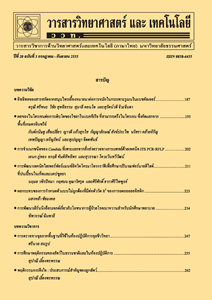ระบบภูมิสารสนเทศเพื่อการคาดการณ์ปริมาณขยะจากการขยายตัวของเมือง
Main Article Content
Abstract
บทคัดย่อ
การศึกษาในครั้งนี้มีวัตถุประสงค์เพื่อคาดการณ์การปริมาณขยะจากข้อมูลของการขยายตัวของพื้นที่เมือง ในเขตเทศบาลตำบลเจ้าพระยาสุรศักดิ์ จังหวัดชลบุรี โดยการหาขนาดของเมืองที่เปลี่ยนแปลงไปนั้นจะใช้การศึกษาการเปลี่ยนแปลงการใช้ประโยชน์ที่ดินปีตั้งแต่ พ.ศ.2546 ถึงปี พ.ศ.2570 ด้วยแบบจำลอง Cellular Automata Markov และนำข้อมูลขนาดของเมืองที่ได้มาทำการคาดการณ์ปริมาณขยะที่เกิดขึ้น และเปรียบเทียบกับการคาดการณ์การปริมาณขยะที่คำนวณจากการเพิ่มของประชากร เพื่อทำการวิเคราะห์และสรุปถึงผลของคาดการณ์การปริมาณขยะที่จะเกิดขึ้นในอนาคต โดยผลการศึกษาการเปลี่ยนแปลงการใช้ประโยชน์ที่ดินแสดงให้เห็นว่าพื้นที่เมืองมีขนาดเพิ่มขึ้น คือในปี พ.ศ.2546 พื้นที่เมืองมีขนาดอยู่ประมาณ 27.10 ตารางกิโลเมตร และในปีในปี พ.ศ.2570 มีขนาดเพิ่มขึ้นเป็นประมาณ 69.55 ตารางกิโลเมตร โดยผลจากการคาดการณ์ปริมาณขยะจากการคำนวณทั้งจากการเปลี่ยนแปลงของประชากรและจากการขยายตัวของเมือง โดยปริมาณขยะจากการคาดการณ์ทั้ง 2 แบบนั้นไม่แตกต่างกันมากนักและมีทิศทางที่เพิ่มขึ้นทุกปี จากผลการศึกษาสามารถสรุปได้ว่า ปริมาณขยะจากการคาดการณ์ด้วยจากการเปลี่ยนแปลงของประชากรและจากการขยายตัวของเมืองนั้นมีความใกล้เคียงกัน ซึ่งสามารถนำเอาผลจากการคาดการณ์ปริมาณขยะจากทั้ง 2 วิธีไปใช้ในการกำหนดนโยบายและแผนในการจัดการขยะมูลฝอยของเทศบาลตำบลเจ้าพระยาสุรศักดิ์ในอนาคตได้
คำสำคัญ : การคาดการณ์ปริมาณขยะ; การขยายตัวของเมือง; ระบบภูมิสารสนเทศ
Abstract
This study aimed to predict quantities of solid waste through urban expansion data in Chaoprayasurasak municipality, Chonburi province. The land use changes from 2003 to 2027 were analyzed to predict the urban expansion through Cellular Automata Markov model. The quantities of solid waste were calculated and compared using the urban expansion and population growth data, to summarize the results of the predicted quantity of solid waste that will occur in the future. The results from land use changes showed that the urban areas from 2003 to 2027 are expanded, which in 2003 urban areas approximately 27.10 km2, and in 2027 urban areas approximately 69.55 km2. The results from predicable quantities of solid waste between population growth and urban expansion data which showed these predicable results were not different and seem to increase every year. Based on these results, it can be concluded about quantities of solid waste that calculated from urban expansion and population growth data were similar, so the results from these 2 methods can support planning and policy determination for managing solid waste in Chaoprayasurasak municipality in the future.
Keyword: solid waste prediction; urban expansion; geo-information system


